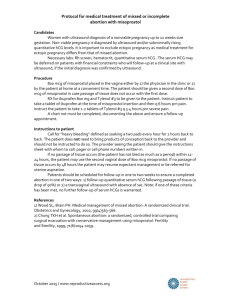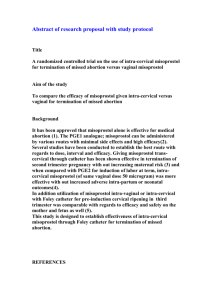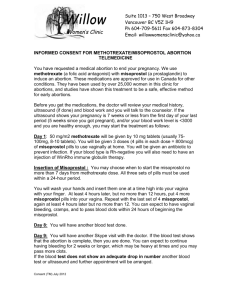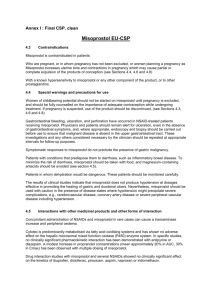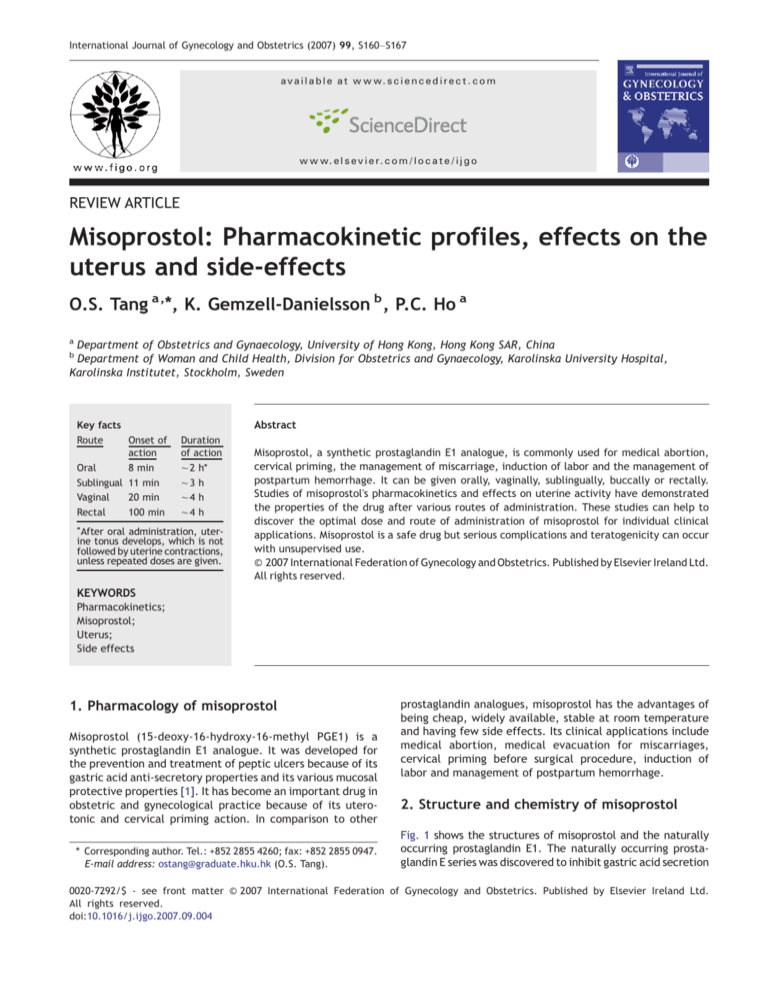
International Journal of Gynecology and Obstetrics (2007) 99, S160–S167
a v a i l a b l e a t w w w. s c i e n c e d i r e c t . c o m
w w w. e l s e v i e r. c o m / l o c a t e / i j g o
REVIEW ARTICLE
Misoprostol: Pharmacokinetic profiles, effects on the
uterus and side-effects
O.S. Tang a,⁎, K. Gemzell-Danielsson b , P.C. Ho a
a
Department of Obstetrics and Gynaecology, University of Hong Kong, Hong Kong SAR, China
Department of Woman and Child Health, Division for Obstetrics and Gynaecology, Karolinska University Hospital,
Karolinska Institutet, Stockholm, Sweden
b
Abstract
Key facts
Route
Onset of
action
Duration
of action
Oral
8 min
∼ 2 h⁎
Sublingual 11 min
∼3 h
Vaginal
20 min
∼4 h
Rectal
100 min
∼4 h
⁎ After
oral administration, uterine tonus develops, which is not
followed by uterine contractions,
unless repeated doses are given.
Misoprostol, a synthetic prostaglandin E1 analogue, is commonly used for medical abortion,
cervical priming, the management of miscarriage, induction of labor and the management of
postpartum hemorrhage. It can be given orally, vaginally, sublingually, buccally or rectally.
Studies of misoprostol's pharmacokinetics and effects on uterine activity have demonstrated
the properties of the drug after various routes of administration. These studies can help to
discover the optimal dose and route of administration of misoprostol for individual clinical
applications. Misoprostol is a safe drug but serious complications and teratogenicity can occur
with unsupervised use.
© 2007 International Federation of Gynecology and Obstetrics. Published by Elsevier Ireland Ltd.
All rights reserved.
KEYWORDS
Pharmacokinetics;
Misoprostol;
Uterus;
Side effects
1. Pharmacology of misoprostol
Misoprostol (15-deoxy-16-hydroxy-16-methyl PGE1) is a
synthetic prostaglandin E1 analogue. It was developed for
the prevention and treatment of peptic ulcers because of its
gastric acid anti-secretory properties and its various mucosal
protective properties [1]. It has become an important drug in
obstetric and gynecological practice because of its uterotonic and cervical priming action. In comparison to other
⁎ Corresponding author. Tel.: +852 2855 4260; fax: +852 2855 0947.
E-mail address: ostang@graduate.hku.hk (O.S. Tang).
prostaglandin analogues, misoprostol has the advantages of
being cheap, widely available, stable at room temperature
and having few side effects. Its clinical applications include
medical abortion, medical evacuation for miscarriages,
cervical priming before surgical procedure, induction of
labor and management of postpartum hemorrhage.
2. Structure and chemistry of misoprostol
Fig. 1 shows the structures of misoprostol and the naturally
occurring prostaglandin E1. The naturally occurring prostaglandin E series was discovered to inhibit gastric acid secretion
0020-7292/$ - see front matter © 2007 International Federation of Gynecology and Obstetrics. Published by Elsevier Ireland Ltd.
All rights reserved.
doi:10.1016/j.ijgo.2007.09.004
Misoprostol: Pharmacokinetic profiles, effects on the uterus and side-effects
S161
represents how rapidly the drug can be absorbed; the peak
concentration (Cmax) reflects how well the drug is being
absorbed while the area under the serum concentration
versus time curve (AUC, equivalent to bioavailability)
denotes the total exposure to the drug.
Figure 1 The structure of misoprostol and naturally occurring
prostaglandin (PGE1).
in 1967 by Robert et al. [2]. However, naturally occurring
prostaglandins have three drawbacks that hindered their
clinical application. These problems were: (1) rapid metabolism resulting in a lack of oral activity and a short duration of
action when given parenterally, (2) numerous side effects, and
(3) chemical instability leading to a short shelf life. Misoprostol
differs structurally from prostaglandin E by the presence of a
methyl ester at C-1, a methyl group at C-16 and a hydroxyl
group at C-16 rather than at C-15. The methyl ester at C-1
increases the anti-secretory potency and duration of action of
misoprostol, whilst the movement of the hydroxyl group from
C-15 to C-16 and the addition of a methyl group at C-16
improves oral activity, increases the duration of action, and
improves the safety profile of the drug.
3. Pharmacokinetic properties of the various
routes of administration of misoprostol
Misoprostol tablets were developed to be used orally. Other
routes of administration, however, including vaginal, sublingual, buccal and rectal, have also been used extensively in
obstetric and gynecological applications. Over the past
decade there have been a number of studies looking at the
pharmacokinetic profile of various routes of administration
of misoprostol. Three pharmacokinetic properties, the peak
concentration, time to peak concentration and the area
under the serum concentration versus time curve were
studied [3–6]. The time to peak concentration (Tmax)
3.1. Oral route
Early studies concentrated on the pharmacokinetic properties after oral administration. After oral administration,
misoprostol is rapidly and almost completely absorbed from
the gastrointestinal tract. However, the drug undergoes
extensive and rapid first-pass metabolism (de-esterification) to form misoprostol acid. Following a single dose of
400 μg oral misoprostol, the plasma misoprostol level
increases rapidly and peaks at about 30 minutes (Fig. 2)
declines rapidly by 120 minutes and remains low thereafter
[3–6].
3.2. Vaginal route
It was found in clinical studies that vaginal administration
was more effective than oral administration in medical
abortion [7,8]. Zieman et al performed the first pharmacokinetic study comparing oral and vaginal routes of administration [3]. In contrast to the oral route, the plasma
concentration increases gradually after vaginal administration, reaching its maximum level after 70-80 minutes before
slowly declining with detectable drug levels still present
after 6 hours.
Although the peak concentration after oral administration is higher than for vaginal administration, the ‘area
under the curve’ is higher when given vaginally. The
greater bioavailability of vaginal misoprostol may help to
explain why it is more effective in medical abortion.
It has been shown that the coefficient of variation of the
AUC after vaginal administration is greater than that after oral
Figure 2 Mean plasma concentrations of misoprostol acid over time (arrowbars = 1 SD). [Tang. Pharmacokinetics of different routes
of administration of misoprostol. Hum Reprod 2002. Reproduced by permission of Oxford University Press].
S162
administration [3]. This means that the vaginal absorption
of misoprostol is inconsistent. In clinical practice, remnants
of tablets are sometimes seen many hours after vaginal
administration, indicating that the absorption is variable and
incomplete. This may be due to the variation between women
in the amount and pH of the vaginal discharge. Variation in the
amount of bleeding during medical abortion may also affect
the absorption of misoprostol through the vaginal mucosa.
Numerous attempts have been made to improve the absorption of vaginal misoprostol.
The addition of water to the misoprostol tablets is a
common practice. However, this has been shown not to
improve the bioavailability of vaginal misoprostol. [4]
3.3. Sublingual route
Recently, sublingual administration of misoprostol has been
studied for medical abortion and cervical priming. The
misoprostol tablet is very soluble and can be dissolved in
20 minutes when it is put under the tongue.
A pharmacokinetic study compared the absorption kinetics
of oral, vaginal and sublingual routes of administration of
misoprostol [4]. It found that sublingual misoprostol has
the shortest time to peak concentration, the highest peak
concentration and the greatest bioavailability when
compared to other routes. (Fig. 2)
The peak concentration is achieved about 30 minutes
after sublingual and oral administration, whereas following
vaginal administration, it takes 75 minutes [4]. Therefore, it
appears that the sublingual and oral routes have the quickest
onset of action. After 400 μg of misoprostol, a sublingual
dose achieves a higher peak concentration than that of oral
and vaginal administration. This is due to rapid absorption
through the sublingual mucosa as well as the avoidance of
the first-pass metabolism via the liver. The abundant blood
supply under the tongue and the relatively neutral pH in the
buccal cavity may be contributing factors. The rapid onset
and high peak concentration means that of all the possible
routes the systemic bioavailability, as measured by the AUC
O.S. Tang et al.
in the first 6 hours, is greatest for sublingual administration.
In contrast to the previous study by Zieman et al. [3], the
AUC360 after oral and vaginal administration are similar but
only 54% and 58% respectively of that after sublingual
administration [4]. The difference in the findings on the
bioavailability of these two studies may be due to the wide
variation in the absorption of misoprostol through the vaginal
mucosa among different women. On the other hand,
although vaginal absorption has been shown to be slower
and the peak concentration lower than that for the other
routes, the serum level of misoprostol is sustained at that low
level for a longer period of time. In fact, at the end of 6 hours
the serum level of misoprostol acid after vaginal administration is higher than those of the sublingual and oral routes.
Therefore, the effect of misoprostol may linger for more
than 6 hours after a single dose, though the threshold serum
level for clinical action is unknown. Recently, a direct vaginato-uterus transport was described for progesterone absorption [9]. A similar mechanism may exist for misoprostol
absorption and may explain the improved clinical performance of vaginal administration.
3.4. Buccal route
Buccal administration is another way of giving misoprostol.
The drug is placed between the teeth and the cheek and
allowed to be absorbed through the buccal mucosa. Clinical
studies, although limited compared to other routes, have
shown that the buccal route is also effective for medical
abortion, cervical priming and labor induction [10–12].
The shape of the buccal route absorption curve is very
similar to that for vaginal absorption but the serum drug
levels attained are lower throughout the 6 hours study
period.(Fig. 3) [6]
After buccal administration the Tmax is 75 minutes which
is similar to that after vaginal administration, but the AUC
of buccal administration is just half that of the vaginal
administration. Another study comparing buccal to sublingual administration has also shown that the AUC of sublingual
Figure 3 Mean serum levels of misoprostol acid in pg/mL for four epithelial routes of misoprostol administration over 5 hours. Error
bars represent standard deviation. [Meckstroth. Misoprostol Absorption and Uterine Response. Obstet Gynecol 2006. Reproduced by
permission of Lippincott Williams & Wilkins].
Misoprostol: Pharmacokinetic profiles, effects on the uterus and side-effects
misoprostol is 4 times that of buccal administration [13]. The
buccal route is a promising way of administering misoprostol
and more studies are required to compare it with other
routes of administration.
3.5. Rectal route
The rectal route of administration has been studied recently
for the management of postpartum hemorrhage. This route of
administration is less commonly used for other applications.
The shape of the absorption curve after rectal administration is similar to that of vaginal administration but its
AUC is only 1/3 that of vaginal administration. (Fig. 3)
The mean Tmax after rectal administration is 40-65 minutes
[6,14], although a recent study reported a much shorter Tmax
of 20 minutes.
An understanding of the pharmacokinetic properties of
different routes of administration can help to design the best
regimens for the various clinical applications. However, it
may not be able to predict clinical outcomes for various
clinical indications. Sublingual misoprostol, which has the
shortest Tmax, is perhaps useful for clinical applications that
require a fast onset of clinical action, such as postpartum
hemorrhage or cervical priming. Vaginal misoprostol on the
other hand, which has a high bioavailability and sustained
serum level, is useful for indications that require a longer
time for the manifestation of its clinical effects, like medical
abortion. The absorption kinetics can also explain why some
routes of administration are associated with a higher
incidence of side effects. Sublingual administration, which
gives the highest Cmax, is associated with highest incidence
of side effects when compared to other routes.
4. Pharmacokinetics in human breast milk
Breastfeeding mothers may be given misoprostol for postpartum hemorrhage prevention and treatment. It is important therefore to consider its potential effects on the fetus.
S163
However, there are very few studies on the pharmacokinetics
of oral misoprostol in breast milk.
Misoprostol was detected in breast milk within 30 minutes of oral administration. The peak concentration was
attained in 1 hour, which is slightly slower than the
plasma level (30 minutes). The level in breast milk
rapidly drops afterwards and is undetectable by 4-5 hours
after ingestion.
The misoprostol acid level in breast milk is only one-third
of that in the plasma [15,16]. There is no data on the
pharmacokinetics of misoprostol in breast milk for non-oral
routes. However, it would be expected that the breast milk
concentration would be lower after vaginal administration
than after oral administration, but might last longer. The
effect of a short exposure to low levels of misoprostol to the
fetus is unknown.
5. Effects on the uterus and the cervix
The uterotonic and cervical softening effects on the female
genital tract were considered as side effects rather than
therapeutic effects when misoprostol was first introduced.
However, it is because of these effects that misoprostol is
so widely used in obstetric and gynecological practice
today.
5.1. Uterus
The effect of misoprostol on uterine contractility was well
studied by Gemzell-Danielsson et al. [17] and Aronsson et al.
[18] (Fig. 4). After a single dose of oral misoprostol there is
an increase in uterine tonus [18,19]. To produce regular
contractions, however, a sustained plasma level of misoprostol is required and this requires repeated oral doses.
The effect of vaginal administration of a single dose of
misoprostol on uterine contractility is initially similar to that
of oral administration: an increase in uterine tonus. However,
after 1-2 h, regular uterine contractions appear and they last
Figure 4 Uterine activity was measured in Montevideo Units (MU). The treatment groups were as follows: vaginal (0.4 mg), oral
(0.4 mg) and sublingual (0.2 and 0.4 mg). Significant differences between the means of the sublingual (0.4 mg) and oral group:
⁎P b 0.05; †pooled sublingual groups (0.2 and 0.4 mg). [Aronsson. Effects of misoprostol on uterine contractility following different
routes of administration. Hum Reprod 2004. Reproduced by permission of Oxford University Press].
S164
O.S. Tang et al.
Figure 5 Mean uterine activity in Alexandria Units for four epithelial routes of misoprostol administration over five hours. Alexandria
Units estimate area under the pressure-across-time curve for uterine contractions. Error bars represent standard deviation. AU,
Alexandria Units. [Meckstroth. Misoprostol Absorption and Uterine Response. Obstet Gynecol 2006. Reproduced by permission of
Lippincott Williams & Wilkins].
at least up to 4 h after the administration of misoprostol
[17]. The development of regular contractions after vaginal
administration may explain the better clinical efficacy of
vaginal administration when compared to oral administration
[7,8].
Recently, sublingual misoprostol was studied in first and
second trimester medical abortion [20,21]. Aronsson et al.
compared the effects of misoprostol on uterine contractility
following different routes of administration [18]. It was
found that the increase in uterine tonus is more rapid and
more pronounced following oral and sublingual treatment
than after vaginal treatment.
The mean time to increase in tonus is 8 and 11 min for oral
and sublingual administration respectively compared
with 20 mins for vaginal administration.
The mean time to maximum tonus is also significantly
shorter for oral and sublingual misoprostol compared to vaginal
administration. One to two hours after the administration of
misoprostol, the tonus begins to decrease. In the case of oral
misoprostol, this is the end of the activity. For vaginal and
sublingual treatment, however, the tonus is slowly replaced by
regular uterine contractions. These regular uterine contractions are sustained for a longer period after vaginal administration than after sublingual treatment, with decreased
activity occurring only after 4 hours (compared to 3 hours
with sublingual). (Fig. 4)
The uterine effect of buccal and rectal administration
was studied by Meckstroth et al. [6] (Fig. 5). It was shown
that the pattern of uterine tonus and contractility of buccal
administration is very similar to vaginal administration, even
though the AUC was 2 times less.
Rectal administration, which has got the lowest AUC,
shows the lowest uterine activity in terms of tonus and
contractility. Furthermore the mean onset of activity was
103 minutes, significantly longer than by other routes. [6]
The studies on uterine contractility so far have shown that
a sustained level, rather than a high serum level, is required
for the development of regular uterine contractions. Studies
have failed to define the threshold serum level for uterine
contractility. It seems that a very low serum level of
misoprostol is required for the development of regular
uterine contractions. This is complicated further by the
fact that the sensitivity of the uterus to prostaglandins
increases with gestation. The clinical effects or actions
required for different indications of use also vary. The
strength of contraction that is required to achieve the
clinical effects usually increases with gestation. For
instance, stronger contractions are required for labor
induction than medial abortion. For medical abortion, the
addition of mifepristone would certainly modify the action of
misoprostol and lower the serum threshold level for uterine
contractility. In addition to uterine contraction, the softening effect of misoprostol on the cervix also contributes to
its clinical action.
5.2. Cervix
There were many clinical studies that have demonstrated the
cervical priming effect of misoprostol in the pregnant state.
Misoprostol has been used extensively for its cervical softening
effect before induction of labor and surgical evacuation of the
uterus. Studies have demonstrated that less force was
required for mechanical dilatation of the cervix if misoprostol was applied before the procedure [22,23]. While this
softening effect on the cervix may be secondary to the
uterine contractions induced by misoprostol, it is more likely
to be due to the direct effect of misoprostol on the cervix.
The uterine cervix is essentially a connective tissue organ.
Smooth muscle cells account for less that 8% of the distal part
of the cervix. The exact mechanism leading to physiological
cervical ripening is not known. The biochemical events that
have been implicated in cervical ripening are (1) a decrease in
Misoprostol: Pharmacokinetic profiles, effects on the uterus and side-effects
total collagen content, (2) an increase in collagen solubility,
and (3) an increase in collagenolytic activity. The changes in
extracellular matrix components during cervical ripening
were described as similar to an inflammatory response [24].
Indeed, during cervical ripening there is an influx of
inflammatory cells into the cervical stroma, which increases
matrix metalloproteinases and thereby leads to the degradation of collagen and cervical softening [25]. It has been
proposed that these cells produce cytokines and prostaglandins that have an effect on extracellular matrix metabolism.
It has also been shown that various prostaglandin analogues
could decrease the hydroxyproline content of pregnant cervix
[26].
The histochemical changes in the pregnant cervix after
misoprostol administration were studied using electron microscopy and proline uptake assay. The mean proline incorporation per μg protein and collagen density, estimated by light
intensity, was significantly less than the control. This indicated
that the action of misoprostol appeared to be mainly on the
connective tissue stroma with evidence of disintegration and
dissolution of collagen [27].
Most of the studies on uterine contractility and cervical
softening after misoprostol have been conducted on pregnant
women. There is, however, evidence suggesting that these
changes also occur in non-pregnant uterus. Some non-pregnant
women experience uterine cramps after misoprostol and
misoprostol has been shown to also have a cervical priming
effect in the non-pregnant state [3,28].
6. Side effects and incidence of fetal
malformations
Misoprostol is a safe and well-tolerated drug. Pre-clinical
toxicological studies indicate a safety margin of at least 5001000 fold between lethal doses in animals and therapeutic
doses in humans [29].
No clinically significant adverse hematological, endocrine, biochemical, immunological, respiratory, ophthalamic, platelet or cardiovascular effects have been found
with misoprostol. Diarrhea is the major adverse reaction
that has been reported consistently with misoprostol, but
it is usually mild and self-limiting. Nausea and vomiting
may also occur and will resolve in 2 to 6 hours.
Some women found an unpleasant taste when it is taken
sublingually or buccally. A sense of numbness over the mouth
and throat has also been reported when it is taken sublingually.
The toxic dose of misoprostol is unknown, but it has been
considered to be a very safe drug. However, a recent case report
has identified a woman who died of multi-organ failure following
an overdose of misoprostol (60 tablets over 2 days) [30].
Fever and chills have also been reported and are common
following high doses in the third trimester or immediate
postpartum period. The typical situation in which this is seen
is when misoprostol is used for the prevention or treatment
of postpartum hemorrhage.
In studies of misoprostol for postpartum hemorrhage
prevention, chills were reported in 32% – 57% of women
receiving misoprostol [31–33]. Hyperpyrexia (N 40 °C) has
been reported in several cases following 600 μg, and
S165
hyperpyrexia with delirium and/or ICU admission has
been reported following 800 μg orally [34].
Another concern about the use of misoprostol is the risk of
uterine rupture, especially in women with a previous uterine
scar. Reports of uterine rupture are rare in first trimester
medical abortion [35], but the risk seems to increase with
gestation. Evidence from the literature shows that most
uterine ruptures that do occur take place during induction of
labor in the third trimester, when it is associated with
previous uterine scar and other risk factors for uterine
rupture [36]. Further details are in the article by Weeks et al
on induction of labor [37].
Infection is not common after medical abortion by
misoprostol. The incidence has been reported to be only
0.92% [38]. Nevertheless, the recent reports on fatal
infection with Clostridium sordellii after using vaginal
misoprostol for abortion has led to concerns over the use of
this method. However, after extensive investigation there is
still no consensus as to the mechanism of infection in these
cases [39]. It is believed that as the overall incidence of
infection remains low, medical abortion should not be
regarded as a method that is associated with a higher
infection rate when compared to the surgical method.
Exposure to misoprostol in early pregnancy has been
associated with multiple congenital defects. However,
mutagenicity studies of misoprostol have been negative and
misoprostol has not been shown to be embryotoxic, fetotoxic
or teratogenic [40]. These malformations, therefore, may be
due to a disturbed blood supply to the developing embryo
during misoprostol-induced contractions.
It is estimated that absolute risk of malformations after
exposure to misoprostol is relatively low, in the order of 1%
among exposed fetuses.
In population registers, the incidence of abnormalities does
not seem high, given that exposure to misoprostol is quite
common among some populations [42].
A wide range of defects is possible depending on the time
of exposure to misoprostol. Central nervous system and limb
defects are the most commonly reported anomalies. Mobius
syndrome, which is characterized by congenital facial
paralysis with or without limb defects, has been associated
with misoprostol exposure [41]. Other abnormalities like
transverse limb defects, ring-shaped constrictions of the
extremities, arthrogryposis, hydrocephalus, holoprosencephaly and exostrophy of the bladder have also been reported
[42]. Fetal malformation is more commonly associated with
the use of misoprostol-only regimen for abortion as compared to sequential regimen using mifepristone and misoprostol. It may be due to the stronger uterine contraction
associated with repeated high doses of misoprostol. Therefore, induced abortion by misoprostol must be performed
under medical supervision. It is important to have informed
consent of the woman before abortion and counsel the
woman on the risk of fetal abnormality if the pregnancy is
continued after exposure to misoprostol.
Acknowledgement
This chapter was developed for a misoprostol expert meeting
at the Bellagio Study Center in Italy, supported by the
S166
Rockefeller Foundation, Ipas, Gynuity Health Projects and
the UNDP/UNFPA/WHO/World Bank Special Programme of
Research, Development and Research Training in Human
Reproduction.
Conflict of interest
The authors do not have any conflict of interest.
References
[1] Watkinson G, Hopkins A, Akbar FA. The therapeutic efficacy of
misoprostol in peptic ulcer disease. Postgrad Med J 1988;64(suppl 1):
60–77.
[2] Robert A, Nezamis JE, Phillips. Inhibition of gastric secretion by
prostaglandins. Am J Dig Dis 1967;12:1073–6.
[3] Zieman M, Fong SK, Benowitz NL, Banskter D, Darney PD.
Absorption kinetics of misoprostol with oral or vaginal administration. Obstet Gynecol 1997;90:88–92.
[4] Tang OS, Schweer H, Seyberth HW, Lee SWH, Ho PC. Pharmacokinetics of different routes of administration of misoprostol. Hum
Reprod 2002;17:332–6.
[5] Khan R, El-Refaey H, Sharma S, Sooranna D, Stafford M. Oral, rectal
and vaginal pharmacokinetics of misoprostol. Obstet Gynaecol
2004;103:866–70.
[6] Meckstroth KR, Whitaker AK, Bertisch S, Goldberg AB, Darney PD.
Misoprostol administered by epithelial routes. Obstet Gynaecol
2006;108:82–90.
[7] El-Refaey H, Rajasekar D, Abdalla M, Calder L, Templeton A.
Induction of abortion with mifepristone (RU 486) and oral or
vaginal misoprostol. N Eng J Med 1995;332:983–7.
[8] Ho PC, Ngai SW, Liu KL, Wong GC, Lee SW. Vaginal misoprostol
compared with oral misoprostol in termination of second
trimester pregnancy. Obstet Gynecol 1997;90:735–8.
[9] Cicinelli E, de Ziegler D, Bulletti C, Matteo MG, Schonauer LM,
Galantino P. Direct transport of progesterone from vagina to
uterus. Obstet Gynecol 2000;95:403–6.
[10] Middleton T, Schaff E, Fielding SL, Scahill M, Shannon C,
Westheimer E, et al. Randomized trial of mifepristone and
buccal or vaginal misoprostol for abortion through 56 days of
last menstrual period. Contraception 2005;72:328–32.
[11] Castleman LD, Oanh KT, Hyman AG, Thuy le T, Blumenthal BD.
Introduction of the dilation and evacuation procedure for secondtrimester abortion in Vietnam using manual vacuum aspiration
and buccal misoprostol. Contraception 2006;74: 272–6.
[12] Carlan SJ, Blust D, O'Brien WF. Buccal versus intravaginal
misoprostol administration for cervical ripening. Am J Obstet
Gynecol 2002;186:229–33.
[13] Schaff EA, DiCenzo R, Fielding SL. Comparison of misoprostol
plasma concentration following buccal and sublingual administration. Contraception 2005;71:22–5.
[14] Khan R, El-Refaey H. Pharmacokinetics and adverse-effect
profile of rectally administered misoprostol in the third stage
labour. Obstet Gynaecol 2003;101:968–74.
[15] Vogel D, Burkhardt T, Rentsch K, Schwee H, Watzer B,
Zimmermann R, et al. Misoprostol versus methylergometrine:
pharmacokinetics in human milk. Am J Obstet Gynecol 2004;191:
2168–73.
[16] Abdel-Aleem H, Villar J, Gulmezoglu AM, Mostafa SA, Youssef AA,
Shokry M, et al. The pharmacokinetics of the prostaglandin E1
analogue misoprostol in plasma and colostrum after postpartum oral
administration. Eur J Obstet Gynecol Reprod Biol 2003;108: 25–8.
[17] Gemzell-Danielsson K, Marions L, Rodriguez A, Spur BW, Wong
PYK, Bygdeman M. Comparison between oral and vaginal
administration of misoprostol on uterine contractility. Obstet
Gynaecol 1999;93: 275–80.
O.S. Tang et al.
[18] Aronsson A, Bygdeman M, Gemzell-Danielsson K. Effects of
misoprostol on uterine contractility following different routes
of administration. Hum Reprod 2004;19:81–4.
[19] Norman JE, Thong KJ, Baird DT. Uterine contractility and
induction of abortion in early pregnancy by misoprostol and
mifepristone. Lancet 1991;338:1233–6.
[20] Tang OS, Chan CCW, Ng EHY, Lee SWH, Ho PC. A prospective,
randomized, placebo-controlled trial on the use of mifepristone with sublingual or vaginal misoprostol for medical abortions of less than 9 weeks gestation. Hum Reprod 2003;18:
2315–8.
[21] Tang OS, Lau WNT, Chan CCW, Ho PC. A prospective randomized
comparison of sublingual and vaginal misoprostol in second trimester termination of pregnancy. Br J Obstet Gynecol 2004;111:
1001–5.
[22] El-Refaey H, Calder L, Wheatley DN, Templeton A. Cervical
priming with prostaglandin E1 analogues, misoprostol and
gemeprost. Lancet 1994;343:1207–9.
[23] Ngai SW, Tang OS, Lao T, Ho PC, Ma HK. Oral misoprostol versus
placebo for cervical dilatation before vacuum aspiration in first
trimester pregnancy. Hum Reprod 1995;10:1220–2.
[24] Liggins G. Cervical ripening as an inflammatory reaction. In:
Ellwood D, Anderson A, editors. The cervical in pregnancy and
labor: clinical and Biochemical Investigations. Edinburgh: Churchill
Livingstone; 1981.
[25] Aronsson A, Ulfgren A, Stabi B, Stavreus-Evers A, GemzellDanielsson K. The effect of orally and vaginally administrated
misoprostol on inflammatory mediators and cervical ripening
during early pregnancy. Contraception 2005;72:33–9.
[26] Rath W, Theobald P, Kuhnle H, Kuhn W, Hilgers H, Weber L.
Changes in collagen content of the first trimester cervix uteri
after treatment with prostaglandin F2 alpha gel. Arch Gynecol
1982;231:107–10.
[27] El-Refaey H, Calder L, Wheatley DN, Templeton A. Cervical
priming with prostaglandin E1 analogues, misoprostol and
gemeprost. Lancet 1994;343:1207–9.
[28] Crane JM, Healey S. Use of misoprostol before hysteroscopy: a
systemic review. I Obstet Gynecol Can 2006;28:373–9.
[29] Kotsonis FN, Dodd DC, Regnier B, Kohn FE. Preclinical toxicology profile of misoprostol. Dig Dis Sci 1985;30(11 Suppl):
142S–6S.
[30] Henriques A, Lourenco AV, Ribeirinho A, Ferreira H, Graca LM.
Maternal death related to misoprostol overdose. Obstet
Gynaecol 2007;109:489–90.
[31] Derman RJ, Kodkany BS, Goudar SS, Geller SE, Naik VA, Bellad MB,
et al. Oral misoprostol in preveting postpartum haemorrhage in
resource-poor communities: a randomized controlled trial. Lancet
2006;368:1248–53.
[32] Hoj L, Cardosa P, Nielsen BB, Hvidman L, Nielsen J, Aaby P.
Effect of sublingual misoprostol on severe postpartum haemorrhage in a primary health centre in Guinea-Bissau: randomized
double blind clinical trial. BMJ 2005;331:723.
[33] Walraven G, Blum J, Dampha Y, Sowe M, Morison L, Winikoff B,
et al. Misoprostol in the management of the third stage of
labour in the home delivery setting in rural Gambia; a
randomised controlled trial. BJOG 2005;112:1277–83.
[34] Chong YS, Chua S, El-Refaey H, Choo WL, Chanrachakul B, Tai BC,
et al. Postpartum intrauterine pressure studies of the uterotonic
effect of oral misoprostol and intramuscular syntometrine. Br J
Obstet Gynaecol 2001;108:41–7.
[35] Kim JO, Han JY, Choi JS, Ahn HK, Yang JH, Kang IS, et al.
Oral misoprostol and uterine rupture in the first trimester of pregnancy. A case report. Reprod Toxicol 2005;20:
575–7.
[36] Plaut MM, Schwartz ML, Lubarsky SL. Uterine rupture associated with the use of misoprostol in the gravid patient with a
previous cesarean section. Am J Obstet Gynecol 1999;180:
1535–42.
Misoprostol: Pharmacokinetic profiles, effects on the uterus and side-effects
[37] Weeks AD, Alfirevic Z, Faundes A, Hofmeyr J, Safar P, Wing D.
Misoprostol for induction of labor with a live fetus. Int J Gynecol
Obstet 2007;99:S194–7 [this issue].
[38] Shannon C, Brothers P, Philip NM, Winikoff B. Infection after
medial abortion: a review of the literature. Contraception
2004;70:183–90.
[39] Fischer M, Bhatnagar J, Guarner J, Reagan S, Hacker JK, Van
Meter SH, et al. Fatal shock syndrome associated with
S167
Clostridium sordellii after medical abortion. N Eng J Med
2005;353:2352–60.
[40] Pastuszak AL, Schuler L, Speck-Martins CE, Coelho KE, Cordello
SM, Vargas F, et al. Use of misoprostol during pregnancy
and Mobius' syndrome in infants. N Engl J Med 1998;338:
1881–5.
[41] Orioli IM, Castilla EE. Epidemiological assessment of misoprostol teratogenicity. Br J Obstet Gynaecol 2000;107:519–23.

